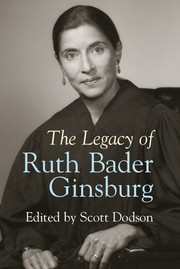Book contents
- Frontmatter
- Contents
- Contributors
- Preface
- Acknowledgments
- Part I Shaping a Legacy
- Part II Rights and Remedies
- Part III Structuralism
- Part IV The Jurist
- 13 Reflections on the Confirmation Journey of Ruth Bader Ginsburg, Summer 1993
- 14 Justice Ginsburg
- 15 Oral Argument as a Bridge between the Briefs and the Court’s Opinion
- 16 Fire and Ice
- Coda
- Notes
- Index
13 - Reflections on the Confirmation Journey of Ruth Bader Ginsburg, Summer 1993
Published online by Cambridge University Press: 05 February 2015
- Frontmatter
- Contents
- Contributors
- Preface
- Acknowledgments
- Part I Shaping a Legacy
- Part II Rights and Remedies
- Part III Structuralism
- Part IV The Jurist
- 13 Reflections on the Confirmation Journey of Ruth Bader Ginsburg, Summer 1993
- 14 Justice Ginsburg
- 15 Oral Argument as a Bridge between the Briefs and the Court’s Opinion
- 16 Fire and Ice
- Coda
- Notes
- Index
Summary
Ruth Bader Ginsburg has been deservedly celebrated for her contributions as a Supreme Court Justice. For those of us in the lower courts who are guided by her opinions, we can only admire the justice’s powerful analytic clarity, the graceful and succinct prose, the capacity to unpack complicated arguments in ways that are fair to all concerned, her collegial tone, and, to borrow a word from her lexicon, her many “pathmarking” contributions to the law’s development. Of course, even if she had never served a day as a judge on any court, Ginsburg would have been a much heralded figure in our nation’s history for her landmark advocacy on behalf of women’s rights. In a life of extraordinary accomplishment, the justice has assumed iconic status for the American public. Greeting cards bear her likeness, operas are written about her, T-shirts with her images are popular gifts, Ruth Bader Ginsburg bobbleheads are hot commodities, a fan website records her wisdom. In a land where the loudest and flashiest often obtain the most celebrity attention, Ruth Ginsburg shares that stage of fame by dint of her intellect, achievements, and vision.
In the course of her Supreme Court confirmation process in the summer of 1993, the general American public first came to know Ruth Bader Ginsburg. What they observed – her character, her values – they liked, and the years since have only reinforced and deepened that connection. I witnessed her confirmation journey firsthand, an experience I will always treasure.
- Type
- Chapter
- Information
- The Legacy of Ruth Bader Ginsburg , pp. 199 - 205Publisher: Cambridge University PressPrint publication year: 2015



